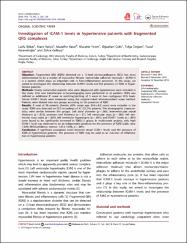| dc.contributor.author | Bekar, Lütfü | |
| dc.contributor.author | Kalçık, Macit | |
| dc.contributor.author | Katar, Muzaffer | |
| dc.contributor.author | Yetim, Mucahit | |
| dc.contributor.author | Çelik, Oğuzhan | |
| dc.contributor.author | Doğan, Tolga | |
| dc.contributor.author | Gölbaşı, Zehra | |
| dc.contributor.author | Karavelioğlu, Yusuf | |
| dc.date.accessioned | 2020-11-20T16:50:11Z | |
| dc.date.available | 2020-11-20T16:50:11Z | |
| dc.date.issued | 2020 | |
| dc.identifier.issn | 0001-5385 | |
| dc.identifier.uri | https://doi.org/10.1080/00015385.2018.1555200 | |
| dc.identifier.uri | https://hdl.handle.net/20.500.12809/6224 | |
| dc.description | PubMed ID: 30650029 | en_US |
| dc.description.abstract | Objective: Fragmented QRS (fQRS) detected on a 12-lead electrocardiogram (ECG) has been demonstrated to be a marker of myocardial fibrosis. Intercellular adhesion molecule-1 (ICAM-1) is a protein which plays an important role in fibro-inflammatory processes. In this study, we aimed to investigate the relationship between ICAM-1 levels and the presence of fQRS in hypertensive patients. Methods: Ninety consecutive patients who were diagnosed with hypertension were included in the study. ECG and transthoracic echocardiography were performed to all patients. fQRS was defined as additional R’ wave or notching/splitting of S wave in two contiguous ECG leads. Serum ICAM-1 levels were measured using the enzyme-linked immunosorbent assay method. Patients were divided into two groups according to the presence of fQRS. Results: A total of 90 patients (female, 65%; mean age: 54.6 ± 8.5 years) were included in the study. fQRS was detected on ECG recordings of 47 (52.2%) patients. The demographic characteristics were similar between the groups. Left atrial diameter (p =.003), interventricular septal thickness (p =.013), posterior wall thickness (p =.01), left ventricular mass (p =.002), left ventricular mass index (p <.001), left ventricular hypertrophy (p =.001), and ICAM-1 levels (p <.001) were found to be significantly increased in fQRS(+) group. In multivariate analysis, only high ICAM-1 level was observed to be an independent predictor for the presence of fQRS (odds ratio: 1.029; 95%Confidence Interval: 1.013–1.045, p <.001). Conclusion: A significant association exists between serum ICAM-1 levels and the presence of fQRS in hypertensive patients. The presence of fQRS may be used as an indicator of inflammation in hypertensive patients. © 2019, © 2019 Belgian Society of Cardiology. | en_US |
| dc.item-language.iso | eng | en_US |
| dc.publisher | Taylor and Francis Ltd. | en_US |
| dc.item-rights | info:eu-repo/semantics/openAccess | en_US |
| dc.subject | Echocardiography | en_US |
| dc.subject | fragmented QRS complex | en_US |
| dc.subject | hypertension | en_US |
| dc.subject | inflammation | en_US |
| dc.subject | intercellular adhesion molecule | en_US |
| dc.subject | myocardial fibrosis | en_US |
| dc.title | Investigation of ICAM-1 levels in hypertensive patients with fragmented QRS complexes | en_US |
| dc.item-type | article | en_US |
| dc.contributor.department | MÜ, Tıp Fakültesi, Dahili Tıp Bilimleri Bölümü | en_US |
| dc.contributor.institutionauthor | Çelik, Oğuzhan | |
| dc.identifier.doi | 10.1080/00015385.2018.1555200 | |
| dc.identifier.volume | 75 | en_US |
| dc.identifier.issue | 2 | en_US |
| dc.identifier.startpage | 123 | en_US |
| dc.identifier.endpage | 129 | en_US |
| dc.relation.journal | Acta Cardiologica | en_US |
| dc.relation.publicationcategory | Makale - Uluslararası Hakemli Dergi - Kurum Öğretim Elemanı | en_US |


















